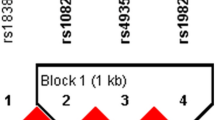Abstract
Hashimoto’s thyroiditis (HT) is an autoimmune disease of the thyroid gland, and like many other autoimmune diseases, it is associated with the HLA and CTLA-4 gene. We have examined the distribution of the HLA DRB4*0101 allele and a CTLA-4 exon 1 A/G polymorphism in Japanese HT patients and controls and investigated possible interactions of these genes with thyroid function. Seventy Japanese HT patients and 105 controls were included in this study. HT was diagnosed on the basis of positivity for thyroid peroxidase (TPO) autoantibodies and the presence of a palpable diffuse goiter. Genotyping was performed by polymerase chain reaction (PCR)-based methods. CTLA-4-GG or -AG was more prevalent in the patients, and the odds ratio for the G allele was 4.95. The frequency of DRB4*0101-positive individuals was significantly higher in HT (odds ratio=2.17). The TSH values of HT patients at the time of diagnosis were compared to CTLA-4 genotype and HLA-DRB4*0101 positivity. They were slightly higher in the CTLA-4-AG group than in the -GG group and significantly higher in the HLA-DRB4*0101-positive group than in the -negative group (p<0.01). When the TSH values were compared in 4 groups based on positivity or negativity for HLA-DRB4*0101 and CTLA-4 GG or AG, they were found to be significantly higher in the CTLA-4-AG and HLADRB4* 0101-positive group than in the 3 other groups (F=5.75, 3 degrees of freedom, p<0.01). These findings suggest that the interaction between the HLA-DRB4 and CTLA-4 genes determines the thyroid function of TPO-positive goitrous Japanese HT patients.
Similar content being viewed by others
References
DeGroot LJ, Quintans J. The causes of autoimmune thyroid disease. Endocr Rev 1989, 10: 537–62.
Weetman AP. Autoimmune thyroiditis: predisposition and pathogenesis. Clin Endocrinol (Oxf) 1992, 36: 307–23.
Farid NR, Sampson L, Moens H, Barnard M. The association of goitrous autoimmune thyroiditis with HLA-DR5. Tissue Antigens 1981, 17: 265–8.
Stenszky V, Balazs C, Kraszits E, et al. Association of goitrous autoimmune thyroiditis with HLA-DR3 in Eastern Hungary. J Immunogenet 1987, 14: 143–8.
Thompson C, Farid NR. Postpartum thyroiditis and goitrous (Hashimoto’s) thyroiditis are associated with HLADR4. Immunol Letters 1985, 11: 301–3.
Mangklabruks A, Cox N, DeGroot LJ. Genetic factors in autoimmune thyroid disease analyzed by restriction fragment length polymorphism of candidate genes. J Clin Endocrinol Metab 1991, 73: 236–44.
Wan XL, Kimura A, Dong RP, Honda K, Tamai H, Sasazuki T. HLA-A and -DRB4 genes in controlling the susceptibility to Hashimoto’s thyroiditis. Human Immunol 1995, 42: 131–6.
Kotsa K, Watson PF, Weetman AP. A CTLA-4 gene polymorphism is associated with both Graves’ disease and autoimmune hypothyroidism. Clin Endocrinol (Oxf) 1997, 46: 551–4.
Awata T, Kurihara S, Iitaka M, et al. Association of CTLA-4 gene A-G polymorphism (IDDM12 locus) with acute-onset and insulin-depleted IDDM as well as autoimmune thyroid disease (Graves’ disease and Hashimoto’s thyroiditis) in the Japanese population. Diabetes 1998, 47: 128–9.
Donner H, Braun J, Seidl C, et al. Codon 17 polymorphism of the cytotoxic T lymphocyte antigen 4 gene in Hashimoto’s thyroiditis and Addison’s disease. J Clin Endocrinol Metab 1997, 82: 4130–2.
Tivol EA, Schweitzer AN, Sharpe AH. Costimulation and autoimmunity. Curr Opin Immunol 1996, 8: 822–30.
Thompson CB, Allison JP. The emerging role of CTLA-4 as immune attenuator. Immunity 1997, 7: 445–50.
Yanagawa T, Hidaka Y, Guimaraes V, Soliman M, DeGroot LJ. CTLA-4 gene polymorphism associated with Graves’ disease in a Caucasian population. J Clin Endocrinol Metab 1995, 80: 41–5.
Nistico L, Buzzetti R, Pritchard LE, et al. The CTLA-4 gene region of chromosome 2q33 is linked to, and associated with, type 1 diabetes. Hum Mol Genet 1996, 5: 1075–80.
Yanagawa T, Gomi K, Nakao E, Inada S. CTLA-4 gene polymorphism in Japanese patients with Rheumatoid arthritis. J Rheumatol 2000, 27: 2740–2.
Huang D, Liu L, Noren K, et al. Genetic association of Ctla-4 to myasthenia gravis with thymoma. J. Neuroimmunol 1998, 88: 92–8.
Kemp EH, Ajjan RA, Husebye ES, et al. A cytotoxic T lymphocyte antigen-4 (CTLA-4) gene polymorphism is associated with autoimmune Addison’s disease in English patients. Clin Endocrinol (Oxf) 1998, 49: 609–13.
Fukazawa T, Yanagawa T, Kikuchi S, et al. CTLA-4 gene polymorphism may modulate disease in Japanese multiple sclerosis patients. J Neurol Sci 1999, 171: 49–55.
Polymeropoulos MH, Xiao H, Rath DS, Merril CR. Dinucleotide repeat polymorphism at the human CTLA4 gene. Nucleic Acids Res. 1991, 19: 4018.
Woolf B. On estimating the relation between blood group and disease. Ann Hum Genet 1955, 19: 251–3.
Owerbach D, Naya FJ, Tsai MJ, Allander SV, Powell DR, Gabby KH. Analysis of candidate genes for susceptibility to type 1 diabetes. A case-control and family-association study of genes on chromosome 2q31–35. Diabetes 1997, 46: 1069–74.
MacKenzie WA, Davies TF. An intrathyroidal T cell clone specifically cytotoxic for human thyroid cells. Immunology 1987, 61: 101–3.
Heward JM, Allahabadia A, Armitage M, et al. The development of Graves’ disease and the CTLA-4 gene on chromosome 2q33. J Clin Endocrinol Metab 1999, 84: 2398–401.
Kouki T, Sawai Y, Gardine CA, Fisfalen ME, Alegre ML, DeGroot LJ. CTLA-4 gene polymorphism at position 49 in exon 1 reduces the inhibitory function of CTLA-4 and contributes to the pathogenesis of Graves’ disease. J Immunol 2000, 165: 6606–11.
Author information
Authors and Affiliations
Corresponding author
Rights and permissions
About this article
Cite this article
Terauchi, M., Yanagawa, T., Ishikawa, N. et al. Interactions of HLA-DRB4 and CTLA-4 genes influence thyroid function in Hashimoto’s thyroiditis in Japanese population. J Endocrinol Invest 26, 1208–1212 (2003). https://doi.org/10.1007/BF03349159
Accepted:
Published:
Issue Date:
DOI: https://doi.org/10.1007/BF03349159



